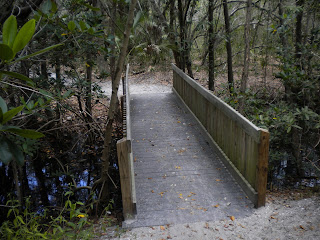Corkscrew Swamp Sanctuary The fieldtrip of Corkscrew Swamp Sanctuary started at the noon of day. Welcomed by the brisk warm winds, I questioned if this was the best time to pursue this task. Determined to pursue this adventure, I confidently stepped forward. The initial sign gave a descriptive overview of the course. It displayed that we would travel through six habitats: pine flat woods, wet prairie, bald cypress, central marsh, lettuce lakes and pond cypress. In the first view steps on the trail, the course is guided by a sturdy hand build wooden platform that varies in height above the ground. Quickly I was embraced by the chirping of many birds. The first of the birds species located in the pine flat woods I encountered was the red shouldered hawk. The bird was actively communicating from a branch on a tall slash pine tree. The area had few tall trees but was dense with ground level vegetation. The ground was very dry with little water in sight. This may have been due to the summer weather waiting the rainy season. As the trail continued we seen sabal pine trees, described as Florida’s state tree, and the troublesome saw palmetto, which I had to cut through many time in land surveying project, were displayed. Within minutes the terrain surrounding us had changed as we continued. No longer was the area open, as we had entered the cypress forest. Sunlight seemed removed between the shades of tall cypress pines. The trees seemed as though they were competing in length for portions of sunlight. The ground seemed deprived of water yet moist. Hovering next to many cypress pines are air plants named tillandsia which absorb the moisture and particles from the humidity. Saw grass is also plentiful in this area which is known to grown in fresh water swamps and wet lands through Florida. It is clear that due to the density and shading for this area, vegetation has more freedom to navigate to suitable hosts. In the pine flat wood area, vegetation in open areas was impacted greatly by suns exposure. The vegetation was deprived from moisture in the soil and the constant exposure left most plants dried or dead. Further along the trail in the lettuce lake area the hierarchy of the environment is displayed. I witnessed a great egret scavenging the drained lakes for a meal. Patiently and cautiously it waited for its prey, a small fish, which it caught. Its confidence grew as its caution dropped. The bird was willing to accept greater risk with recent success not knowing it was targeted as a meal by an American alligator. Throughout the trail, water was scarce as drought had settled in. In observing the adaptation of the vegetation to its habitat, it seemed as though the larger vegetation in the dense area had its base above ground level and only its roots secured into the ground. The smaller vegetation like parasites clung onto the larger vegetation in reliance. In the open areas, it was opposite, here each plant had to establish it own means of support by digging into the soils to secure moisture and nourishments. Throughout the trail of the walkway, there were trees in the middle of the path. Specific effort had been made not to remove the tree. The wooden boards instead we especially cut to include the trees as part of the walkways landscape. To me this plays a significant role, reminding us that is very possible to construct around the environment creating a win-win effort so all life form can co-exist on this earth. To think that these habitats were the normal environment our forefathers had to endure is humbling. It is even more amazing that availability of this environment is becoming a scarcity to us all each and every day.
· The three habitats identified were: Pine Flatwoods, Cypress Forest and Marsh
· The 5 plants in each habitat were:
Pine Flatwood (seen only 4): slash pine, sabal pine, saw palmetto, wax murtle
Cypress Forest: pond cypress, bald cypress, strangler fig, Spanish moss, airplants
Marsh: water lettuce, resurrection fern, old man’s beard lichen, pickerelweed, pond apple.
· 10 animals identified: great erget, swallow-tailed kite, red-shouldered hawk, red-bellied woodpecker, gray catbird, American alligator, florida redbelly turtle, green anole, brown anole, southeastern lubber grasshopper.
· The landscape creates natural ponds and retains all the water of a specific area in natural made ponds due to elevation difference. The ground absorbs the water until it will be soaked. From there the water will be retained as a pond or lake since the natural ground cannot absorb anymore.
· This environment provides many insects needed to our system of living organisms. As a proclaimed intellectual species we need rapidly grow aware of the immediate urgency to preserve and restore a great portion of the developed world back to it original position in order to prevent the weighs of balances from tipping.













